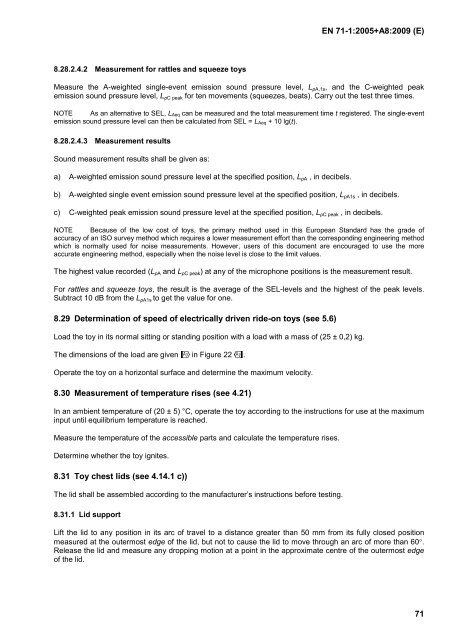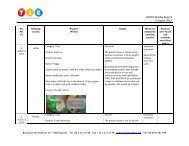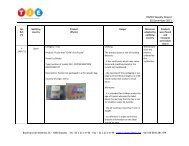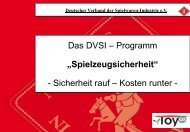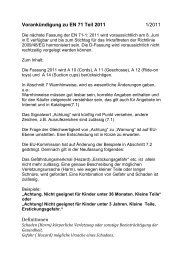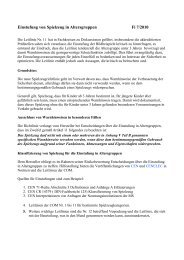You also want an ePaper? Increase the reach of your titles
YUMPU automatically turns print PDFs into web optimized ePapers that Google loves.
8.28.2.4.2 Measurement for rattles and squeeze toys<br />
<strong>EN</strong> <strong>71</strong>-1:<strong>2005+</strong><strong>A8</strong>:2009 (E)<br />
Measure the A-weighted single-event emission sound pressure level, LpA,1s, and the C-weighted peak<br />
emission sound pressure level, LpC peak for ten movements (squeezes, beats). Carry out the test three times.<br />
NOTE As an alternative to SEL, LAeq can be measured and the total measurement time t registered. The single-event<br />
emission sound pressure level can then be calculated from SEL = LAeq + 10 lg(t).<br />
8.28.2.4.3 Measurement results<br />
Sound measurement results shall be given as:<br />
a) A-weighted emission sound pressure level at the specified position, LpA , in decibels.<br />
b) A-weighted single event emission sound pressure level at the specified position, LpA1s , in decibels.<br />
c) C-weighted peak emission sound pressure level at the specified position, LpC peak , in decibels.<br />
NOTE Because of the low cost of toys, the primary method used in this European Standard has the grade of<br />
accuracy of an ISO survey method which requires a lower measurement effort than the corresponding engineering method<br />
which is normally used for noise measurements. However, users of this document are encouraged to use the more<br />
accurate engineering method, especially when the noise level is close to the limit values.<br />
The highest value recorded (LpA and LpC peak) at any of the microphone positions is the measurement result.<br />
For rattles and squeeze toys, the result is the average of the SEL-levels and the highest of the peak levels.<br />
Subtract 10 dB from the LpA1s to get the value for one.<br />
8.29 Determination of speed of electrically driven ride-on toys (see 5.6)<br />
Load the toy in its normal sitting or standing position with a load with a mass of (25 ± 0,2) kg.<br />
The dimensions of the load are given -in Figure 22..<br />
Operate the toy on a horizontal surface and determine the maximum velocity.<br />
8.30 Measurement of temperature rises (see 4.21)<br />
In an ambient temperature of (20 ± 5) °C, operate the toy according to the instructions for use at the maximum<br />
input until equilibrium temperature is reached.<br />
Measure the temperature of the accessible parts and calculate the temperature rises.<br />
Determine whether the toy ignites.<br />
8.31 Toy chest lids (see 4.14.1 c))<br />
The lid shall be assembled according to the manufacturer’s instructions before testing.<br />
8.31.1 Lid support<br />
Lift the lid to any position in its arc of travel to a distance greater than 50 mm from its fully closed position<br />
measured at the outermost edge of the lid, but not to cause the lid to move through an arc of more than 60°.<br />
Release the lid and measure any dropping motion at a point in the approximate centre of the outermost edge<br />
of the lid.<br />
<strong>71</strong>


